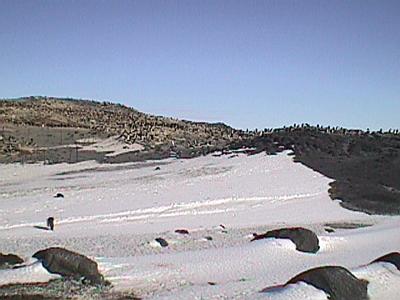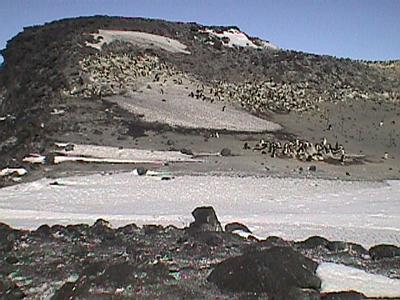
|
|
19 November, 1999
The drilling for the third season of the Cape Roberts Project is completed.
As of November 19th at 10:00AM NZT the drilling stopped at a depth 939.42.
meters. This is now the record for drilling into rock in Antarctica. As I
told you in a previous journal, drilling has brought up rock which was
unexpected by the scientists. They are now in the process of considering
what steps to follow next. Since this is a new and surprising find, they
want to proceed cautiously in order to get as much new information out of
the core samples as possible. The geologists are working to interpret the
meaning of the rocks that have been brought up. There is much discussion
about various interpretations. I will attempt to give you a clearer picture
as to what they have found in a later journal.
I finally got to see penguins! And I didn't see one penguin or even
hundreds. I saw thousands of penguins! I visited the Adelie penguin rookery
at Cape Royds on Ross Island. This is the southern-most penguin rookery in
the world. Adelie penguins (Pygoscelis adeliae) are about 2-3 feet tall and
weigh about 11 pounds. They have the classic black and white penguin
coloration. Their heads, beaks, necks, backs, eyes and tails are all black
with white chests, abdomens, and legs. They have a very distinctive white
circle around their eye. The Adelie penguin is named for Adele, the wife of
Jules-Sebastian Dumont d'Urville, an early French Antarctic explorer.
At Cape Royds, the penguins seem to be everywhere. You can hear their
squabbling sounds as you approach the rookery. You cannot get real close to
the penguins because the rookery is protected and signs are posted to
prevent people form disturbing them. The penguins were nesting when I saw
them and many of the nests had eggs. The nests are composed of small pebbles
arranged in a circle on top of bare rock. The Adelies are very amusing to
watch. They have a hilarious habit of walking over to the nest of another
Adelie and stealing small pebbles. They then scurry away and deposit the
pebble in their nest. This "thievery" inevitably starts a big squabble
between the Adelies that usually results in the victim going and stealing a
pebble from another nest. This goes on all day. I saw penguins waddle about
and slide on their bellies in the snow. They seemed oblivious to our
presence as long as we didn't get too close. I could have watched them for
hours. Oh, and here is something I found out about Adelie penguins I didn't
know; They stink! I got down wind of the rookery and, whew, what an odor. I
guess if we ate what they eat, we wouldn't smell too good either.
Adelie penguins eat plankton, squid and small fish so they need to get to
the sea to feed. The ice will eventually melt around Cape Royds, but now the
open water is about 10 miles away. During my visit, I watched several groups
of Adelies heading out across the ice, waddling along in lines of 3 to 5.
They looked like solders in a line. Several other groups were returning as
well. It was a real high point of my trip so far to see these wonderful
animals in their natural setting. If you want to find out more about Adelie
penguins and other types of Antarctic penguins, check out this website:
http://www.antarctic.com.au/encyclopaedia/bio/Penguins.html.
Seeing that I finally saw an Antarctic penguin, it is time to name my little
penguin friend that has accompanied me all the way from Appleton to
Antarctica and every where in between. Those of you who were at schools I
visited before I left will remember my little stuffed penguin. He/she still
doesn't have a name and it is time to give him/her one. I want you to think
of a good name. If you are reading this in your classroom, perhaps your
class can discuss names and come up with some good ones. When you think you
have a name for "the unnamed penguin", e-mail it to me at
smithbr@mcmurdo.gov. In about a week, I will discuss the names with a panel
of penguin experts (Should be easy to find some around here.), and we will
come up with a list of finalists. Then we will all vote on the best name.
He/she has to have a name before I leave the ice. Come up with some good,
creative names!

I didn't take this picture, but this is a good look at what an Adelie penguin looks like. It came from this web site: http://www.best5.net/animal/ViewImg.cgi?img=a5/AdeliePenguin_walks_I-by_Lind a_Bucklin.jpg

Here is what an Adelie penguin nest looks like with an egg. I saw lots of these at the rookery, but this image came from http://www.partytown.com/menus/adelie.htm.

Here is part of the Adelie rookery at Cape Royds. The penguins were nesting and many had eggs.

Here is another part of the rookery. Can you see the penguins on the snow?

Here is another view of the rookery. If you look real close at the right of the image, you may be able to make out a fenced-in area. Apparently these penguins were isolated as part of a scientific study.

Please give me a name!
Contact the TEA in the field at
.
If you cannot connect through your browser, copy the
TEA's e-mail address in the "To:" line of
your favorite e-mail package.
|
